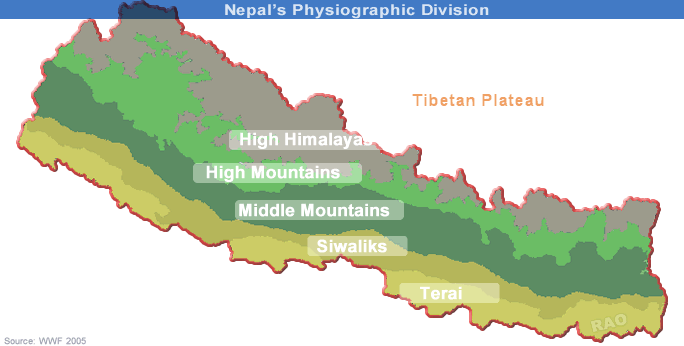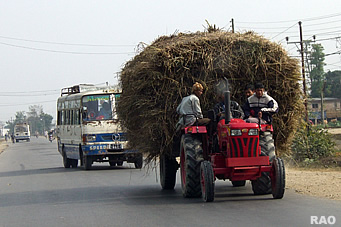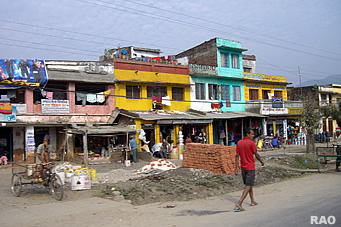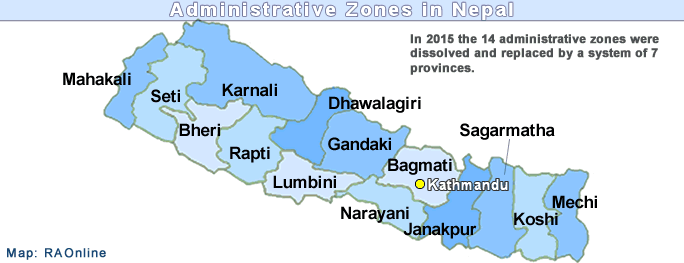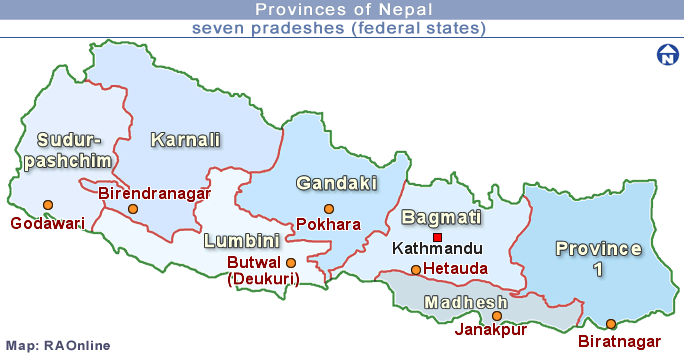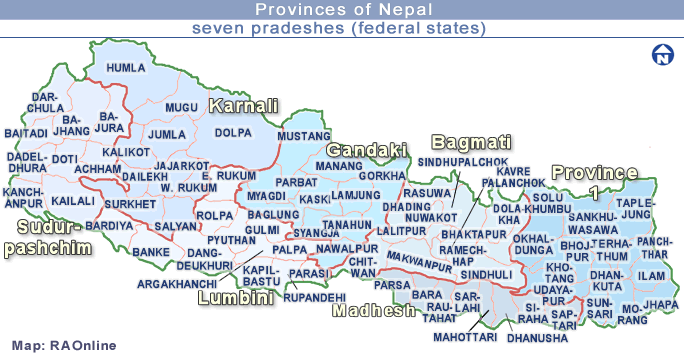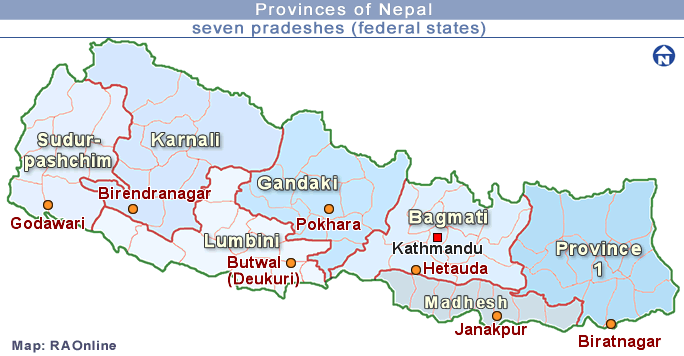 |
Nepal SOCIAL LIFE |
 |
Nepal Information |
|
|
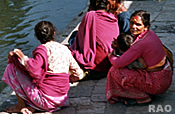 |
|
Background
of the Terai's Madhesi people
|
 |
The
flat southern region of Nepal - the Terai - is known as Madhes in the Nepalese
language and its indigenous inhabitants are called Madhesi.
The
Terai stretches from the east to the west of the country along the Nepalese-Indian
border adjoining the Indian states of Bihar, Uttar Pradesh and West Bengal.
It comprises nearly 17 percent of the land and the Madhesi people make
up about 30 percent of the 27 million people in Nepal.
 |
| Terai |
The
Madhesi are predominantly Hindus with some Muslims, Buddhists and Christians.
Economically,
the Terai is the most fertile and productive region of Nepal where agriculture
dominates. The main agricultural products are rice, jute, sugar, mustard,
tobacco, herbs and spices. Most of the agro-based industries are here.
In addition, the region is rich in forestry.
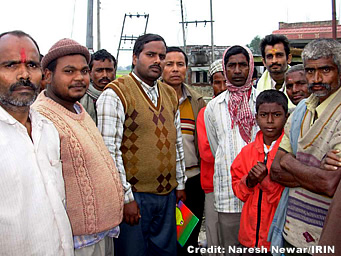 |
| Despite
the economic significance of the Madhesi people, they have felt neglected
by successive Nepalese governments over education, health access, economic
activities and development programmes. Many of the poorest communities
survive on less than US$1 a day.
The
Madhesi leaders accuse the Nepalese government of treating them as outsiders
and not as part of Nepal due to their Indian roots. More than 40 percent
of the Madhesi still do not have citizenship or voting rights and only
15 percent of the 330 Nepalese parliamentarians are Madhesi. |
|
In
a bid to gain the attention of the government, the pro-Terai political
party, the Madhesi People's Rights Forum (MPRF), launched demonstrations
on 16 January to demand greater autonomy and more representation in the
government. Their demands also include citizenship for the Madhesi population.
The
government has yet to decide how to respond to the demands of the Madhesi
protesters. In three weeks, 19 people have been killed, mostly at the hands
of the armed Nepalese police. Most of the towns and cities in the eastern
Terai remain closed due to strikes, a curfew and violence.
top
|
Madhesis
in the remote villages of southeastern Terai fear they will suffer more
hardship
|

|
KATAHARI,
18 February 2007 (IRIN)
With
only one day to go before a 10-day deadline set by Madhesi leaders for
the government to meet their demands expires, community leaders and aid
agencies are worried that violence will erupt again in the eastern part
of Nepal's southern Terai region.
From
17 January to 8 February, protesters clashed with police during demonstrations
by the ethnic Madhesi people, led by their political party, the Madhesi
People's Rights Forum (MPRF). The clashes, in which thousands of people
were injured and 31 killed, ended on 8 February after the government agreed
to talk to Madhesi leaders about their demands for greater autonomy and
political rights.
There
has been no breakthrough in the negotiations, however, so people in the
region are bracing themselves for possible disruptions and food shortages.
During the earlier protests, most of the cities and towns in the region
came to a complete standstill because of strikes and a curfew. Trucks transporting
food grains, vegetables and other agricultural products were also not allowed
to move from markets to villages.
"Poor
people like us suffered the most due to a lack of food stocks. We could
not afford to buy food in bulk to last for weeks," said Anil Mangal, a
15-year-old rickshaw driver, who is his family's breadwinner.
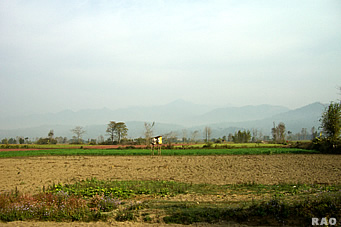 |
| "Poor
people like us suffered the most due to a lack of
food
stocks. We could not afford to buy food in bulk to last for weeks"
Mangal
lives in Katahari village, 20km from Biratnagar, the largest eastern city,
600km east of Kathmandu, the capital. He is working more than 12 hours
a day to earn enough to store food supplies for his family to last for
a few weeks. He says he is worried that if he fails, he and his parents
will suffer food shortages as they did during the protests. |
|
"We
had to beg food from door to door in the village [during the protests]
as all the food markets and shops were closed," he said adding that the
government made the situation worse by imposing a 12-hour (9 a.m. to 9
p.m.) curfew for three weeks.
Katahari
village, with a population of 6,000, was one of the most severely affected
areas in the eastern Terai, where villagers said they were arrested and
beaten by the police for participating in the protests. Many said they
were just spectators and some were forced to join in the protests by the
Madhesi leaders.
"Nearly
500 people were injured in this village alone and although they are gradually
recovering, they still live with fear and uncertainty about how they will
live if the violence recurs," said Lal Bahadur Kamat, a 35-year-old farmer,
who showed IRIN his head injuries after being battered by the police.
Most
of the villagers work as farmers and labourers in local factories for a
daily wage. They said the local administration had failed to help the impoverished
families who had lost all their income and could not afford to buy food.
Terai
unrest
 |
-
Terai is home to ethnic Madhesi people
-
31 people were killed in the Terai violence
-
Thousands were injured
-
Civilians fear violence will resume after 18 February.
"It
will take us another three months to make up for our lost income and now
people are eating only vegetables as they don't have enough rice [the staple
food] because they cannot afford to buy it," said a resident, Jairam Kamot. |
|
"The
situation was quite grave during the curfews and strikes. Many families
were having difficulty finding food and medicines for their children,"
said a community worker, Shakuntala Pande.
| Madhesi
factbox |
 |
 |
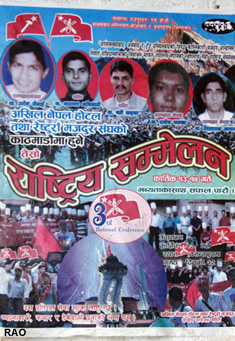 |
 Nepal's largest
ethnic group; make up about one third of Nepal's 27 million people Nepal's largest
ethnic group; make up about one third of Nepal's 27 million people
 Concentrated
in the lowland Terai region, southern Nepal, the country's industrial and
agricultural heartland Concentrated
in the lowland Terai region, southern Nepal, the country's industrial and
agricultural heartland
 Traditionally,
their main ethnic rivals are the politically dominant hill people known
as Pahades Traditionally,
their main ethnic rivals are the politically dominant hill people known
as Pahades
 Comprised
of various sub-groups with several different languages and dialects and
have only recently developed a political consciousness and unity of purpose Comprised
of various sub-groups with several different languages and dialects and
have only recently developed a political consciousness and unity of purpose
 Campaign
for regional autonomy for the Terai, a federal Nepal, and greater representation
in parliament Campaign
for regional autonomy for the Terai, a federal Nepal, and greater representation
in parliament
 Militant
factions such as the Madhesi People's Rights Forum (MPRF) and the Janatantrik
Terai Mukti Morcha (JTMM) have carried out violent acts Militant
factions such as the Madhesi People's Rights Forum (MPRF) and the Janatantrik
Terai Mukti Morcha (JTMM) have carried out violent acts
 Not
allied in any way to the Maoists who have separate political goals Not
allied in any way to the Maoists who have separate political goals
 Include
some of the most impoverished and disadvantaged castes in Nepal such as
Badis (traditional sex workers) and Kamaiyas (bonded labourers) Include
some of the most impoverished and disadvantaged castes in Nepal such as
Badis (traditional sex workers) and Kamaiyas (bonded labourers)
According
to rights activists, Maoist leaders are unable to control their supporters. |
|
 |
 |
Credit
IRIN 2007
Integrated
Regional Information Networks (IRIN), part of the UN Office for the Coordination
of Humanitarian Affairs (OCHA). |
 |
 |
| Terai |
 |
 |
Externe
Links |
top
|
Madhesis-
Teraians: Related Reports
|

|
 |
 |
Externe
Links |
| ANTA Association of Nepalese Teraians in America (ANTA)
|

|
Nepal
Horizons
|
 |
|

|
| more information |
 |
|









